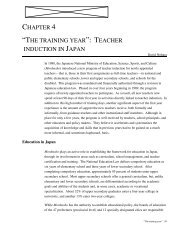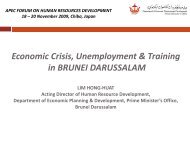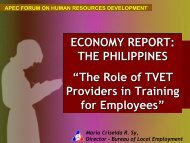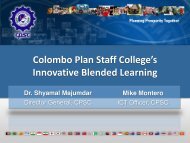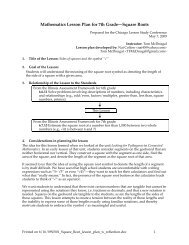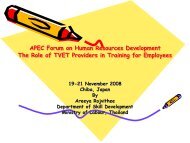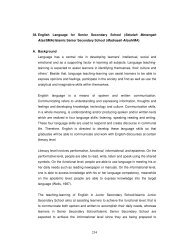Technology-Based Learning Strategies Report - APEC HRDWG Wiki
Technology-Based Learning Strategies Report - APEC HRDWG Wiki
Technology-Based Learning Strategies Report - APEC HRDWG Wiki
You also want an ePaper? Increase the reach of your titles
YUMPU automatically turns print PDFs into web optimized ePapers that Google loves.
C. Methodologies and ToolsGoal-<strong>Based</strong> Scenarios are simulations in which learners assume a major role in thepursuit of a well-defined mission or task. In order to achieve the goal the learner needs toacquire particular skills and knowledge, which is where the learning occurs.Gaming involves more complex simulations with “(1) formal rules in which playersengage in artificial conflict with variable and quantifiable outcomes and both game playand learning objectives, (2) a narrative which provides cues, context and relevance for theactivities, and (3) a simulation which represents the learning space necessary to supportthe activities and narrative.” 26<strong>Learning</strong> Management Systems (LMSs) typically register, track, and deliver content tolearners; report on learner progress, assessment results, and skill gaps for instructors;enroll learners; and provide security and manage user access for administrators. LMSstypically handle courses by multiple publishers and providers. They are similar to<strong>Learning</strong> Content Management Systems (LCMS) that are especially designed tohandle content objects in modular form for learner use.Integrated <strong>Learning</strong> Systems (ILSs) are different from LMSs in that they are fullyintegrated around a specific learning content and are not designed to handle learningobjects from disparate sources. ILSs typically include hardware, as well as curricula andlessons organized by competency level. They usually include a number of tools such asassessments, record keeping, report writing, and user information files that help toidentify learning needs, monitor progress, and maintain student records.The delivery of these methods and their application are elaborated upon in the sections below.Synchronous and Asynchronous Delivery Modes<strong>Technology</strong>-based learning is grouped into synchronous and asynchronous delivery modes. TBLcourses often employ both modes in a form of blended learning.Synchronous learning delivery occurs when instructors and learners meet at a specific time in aphysical or virtual classroom, in person or via Internet, satellite, or phone link-up. In a TBLsetting, synchronous learning occurs in broadcasted lectures, teleconferences, video conferences,or webinars. In webinars and web conferences, audio lectures are often accompanied by slidesand sometimes a video image of the instructor is streamed to the learner’s desktop. As costs forsuch web conferences have come down and tools have become more user friendly, synchronous26Definition adapted from the Advanced Distributed <strong>Learning</strong>, 2005.15



